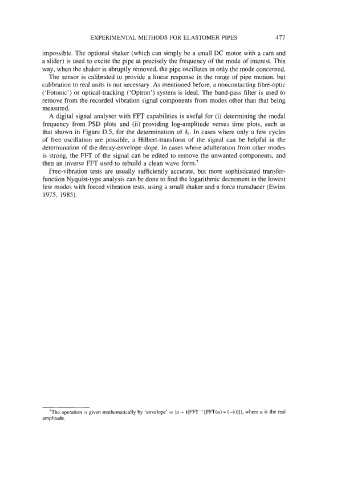Page 507 - Fluid-Structure Interactions Slender Structure and Axial Flow (Volume 1)
P. 507
EXPERIMENTAL METHODS FOR ELASTOMER PIPES 477
impossible. The optional shaker (which can simply be a small DC motor with a cam and
a slider) is used to excite the pipe at precisely the frequency of the mode of interest. This
way, when the shaker is abruptly removed, the pipe oscillates in only the mode concerned.
The sensor is calibrated to provide a linear response in the range of pipe motion, but
calibration to real units is not necessary. As mentioned before, a noncontacting fibre-optic
(‘Fotonic’) or optical-tracking (‘Optron’) system is ideal. The band-pass filter is used to
remove from the recorded vibration signal components from modes other than that being
measured.
A digital signal analyser with FIT capabilities is useful for (i) determining the modal
frequency from PSD plots and (ii) providing log-amplitude versus time plots, such as
that shown in Figure D.5, for the determination of Si. In cases where only a few cycles
of free oscillation are possible, a Hilbert-transform of the signal can be helpful in the
determination of the decay-envelope slope. In cases where adulteration from other modes
is strong, the Fl;T of the signal can be edited to remove the unwanted components, and
then an inverse FFT used to rebuild a clean wave form.+
Free-vibration tests are usually sufficiently accurate, but more sophisticated transfer-
function Nyquist-type analysis can be done to find the logarithmic decrement in the lowest
few modes with forced vibration tests, using a small shaker and a force transducer (Ewins
1975, 1985).
‘The operation is given mathematically by ‘envelope’ = la + i(FF-’[FFT(a) * (-i)]]l, where a is the real
amplitude.

